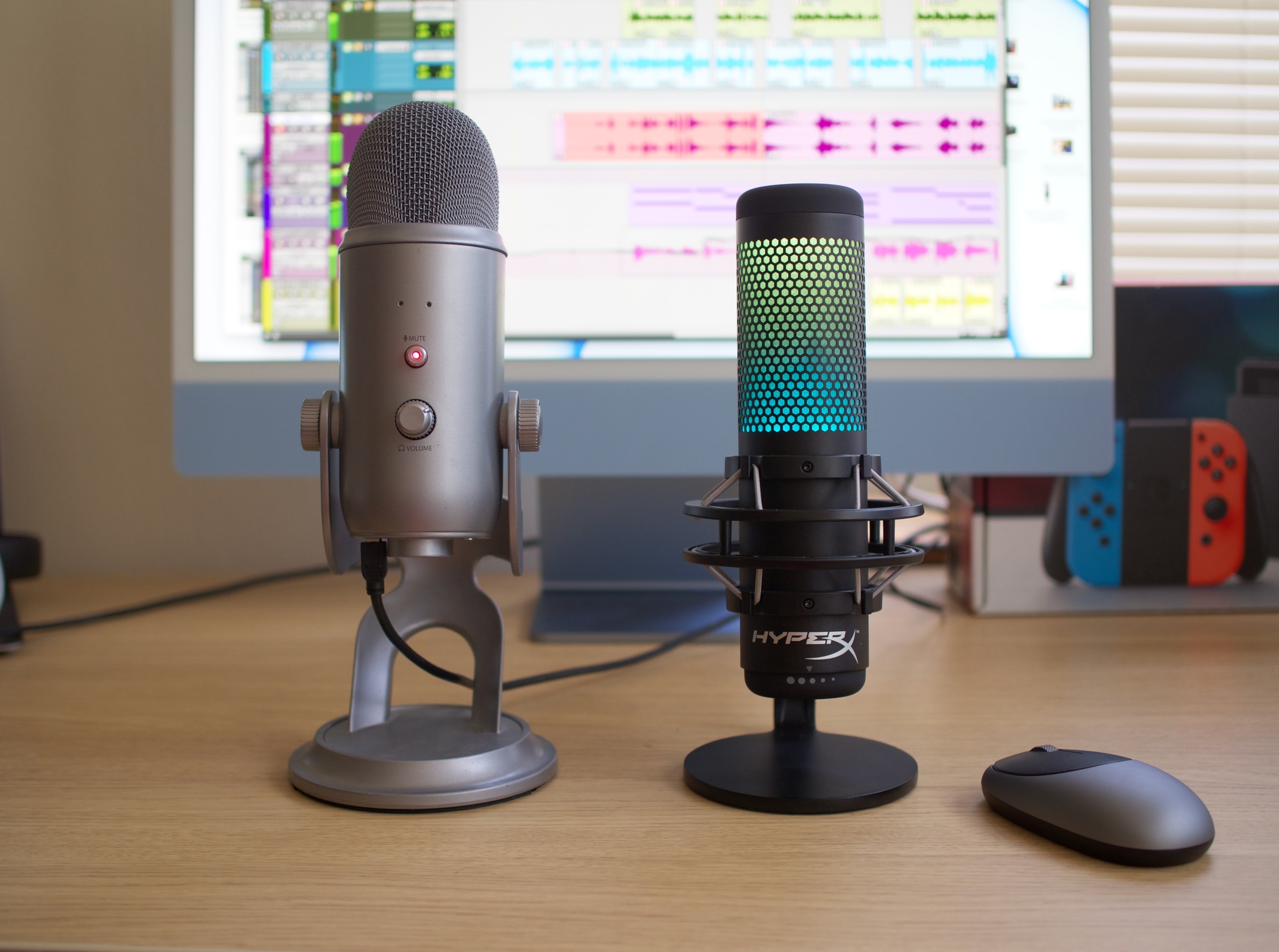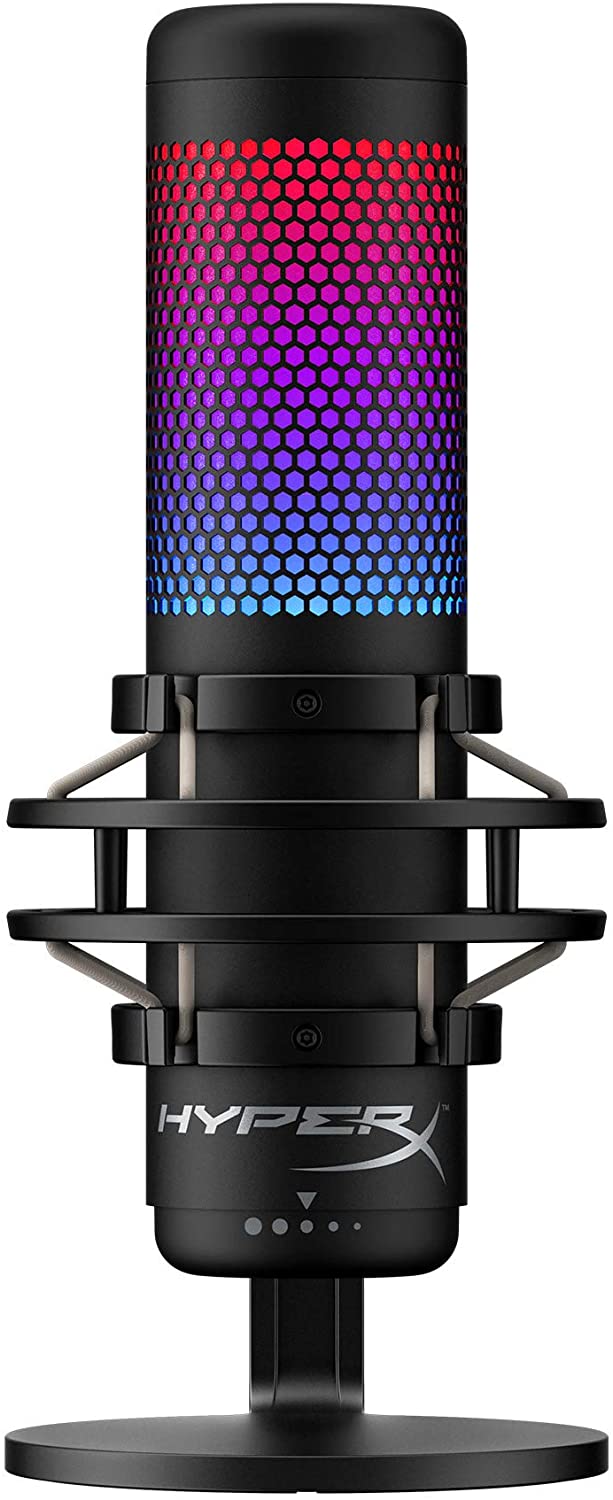HyperX QuadCast S vs. Blue Yeti: Which should you buy?


RGB lighting and a sleek design
The HyperX QuadCast S looks gorgeous on your desk or video if you're streaming, and the gain control and mute button are a lot easier to use while recording. While the Mac can't take full advantage of all its features due to software limitations, the built-in pop filter and shock mount are super useful.
Pros
- Beautiful RGB lighting
- Four polar patterns
- Great clear audio
- A sleeker design
Cons
- Not all features are available on Mac
- More expensive

A bit cheaper with most of the same functionality
The big Blue Yeti has long been a great USB microphone for Mac, and even though it's older and uses a micro-USB connection, it still offers a lot for its price.
Pros
- Sturdy metal design
- Four polar patterns
- Great clear audio
- Cheaper
Cons
- No built-in pop filter
- No shock mount
The HyperX QuadCast S and the Blue Yeti have the same four polar patterns for recording, cardioid, stereo, bidirectional, and omnidirectional and record audio at the same sample rate of 48 kHz/16-bit. That means both microphones will be just as versatile for recording in multiple situations. However, the QuadCast S does come with a built-in pop filter and shock mount, which does help minimize some background noise on a hot mic. So, which one should you get? Let's dive in.
HyperX QuadCast S vs. Blue Yeti: The specs
The Blue Yeti has been on top of mind for many people as the best USB microphone for Mac for years now. When it comes to plug-and-play microphones, it's hard to find something that offers the same versatility at the same price. While the QuadCast S is more expensive than the Blue Yeti, it offers a lot of the same functionality and comes with a few extras that make it a compelling package.
| Header Cell - Column 0 | HyperX QuadCast S | Blue Yeti |
|---|---|---|
| Price | $110 | $160 |
| Connection | microUSB | USB-C |
| Sample rate | 48kHz | 48kHz |
| Bit rate | 16-bit | 16-bit |
| Polar patterns | cardioid, stereo, bidirectional, and omnidirectional | cardioid, stereo, bidirectional, and omnidirectional |
| Condensers | Three 14mm condensers | three 14mm condensers |
| Compatible with mic stands | Yes | Yes |
| Weight (with stand) | 1.32 lbs | 2.2 lbs |
| Pop filter | Built-in | Add-on |
| Shock Mount | Built-in | Add-on |
As someone who has used both microphones, I prefer the QuadCast S from a usability standpoint. While both the Yeti and the QuadCast S have gain control and a mute button, the HyperX microphone just handles it much better. Let's break it down a little more.
HyperX QuadCast S vs. Blue Yeti: It mostly comes down to function
The gain control on the Blue Yeti is a knob located at the back of the microphone, so if you're trying to adjust your gain on the fly, you have to reach around the microphone. Not only is this awkward to do, but it usually results in a bit of noise on the recording. The same goes with the mute button. It's on the front of the Blue Yeti, but it's a clickable little button that always creates a little pop while you're recording.
One thing the Blue Yeti does have going for it is it's fully compatible with Mac.
The QuadCast S, on the other hand, has a nice smooth-turning knob for the gain control located at the bottom of the microphone that's easily accessible. While testing, I found it very easy to adjust the gain without creating much noise on the hot mic. The mute button is a touch button right on top of the device that takes a very slight tap to activate. You might hear a very slight disturbance in your recording, but once again, if you're careful, you can use the mute button without making any noise on the hot mic.
One thing the Blue Yeti does have going for it is it's fully compatible with Mac, whereas the QuadCast S is missing some features because it doesn't have Mac-compatible software. It's not missing anything super important, but without the software HyperX makes, you won't be able to customize the RGB lighting or use any of its custom effects. This likely shouldn't be a deal-breaker for most people, but you will get a little more out of it when it connects to a Windows computer.
HyperX QuadCast S vs. Blue Yeti: Which should you buy?
It may look like the price is the determining factor for two microphones that record equally well and have the same polar patterns, but looks can be deceiving.
iMore offers spot-on advice and guidance from our team of experts, with decades of Apple device experience to lean on. Learn more with iMore!
The Blue Yeti is older, and its price tends to fluctuate more, meaning you can often find it between $110 - $130, but you may see it go even as low as $90 sometimes, but it doesn't come with a pop filter, or shock mount like the QuadCast S does. While the shock mount may not be necessary if you just plan on using the Blue Yeti on your desk in its stand, the pop filter certainly makes a difference. Plus, the Blue Yeti connects via micro-USB. To use it with a more recent Mac, you definitely need a dongle or a good USB-C hub.
When you combine the fact that the QuadCast S is a tad easier to use, uses a USB-C connection, has a more compact and stylish design, and has a built-in pop filter and shock mount, I think it more than justifies its $160 price.

A USB microphone with great usability
While you can't customize the RGB lighting on the Mac, the four polar patterns, the excellent sound quality, and the inclusion of the pop filter and shock mount included with the microphone make for a really pleasant experience regardless of how you use it.

Luke Filipowicz has been a writer at iMore, covering Apple for nearly a decade now. He writes a lot about Apple Watch and iPad but covers the iPhone and Mac as well. He often describes himself as an "Apple user on a budget" and firmly believes that great technology can be affordable if you know where to look. Luke also heads up the iMore Show — a weekly podcast focusing on Apple news, rumors, and products but likes to have some fun along the way.
Luke knows he spends more time on Twitter than he probably should, so feel free to follow him or give him a shout on social media @LukeFilipowicz.

